2012 PEUGEOT 5008 weight
[x] Cancel search: weightPage 212 of 340
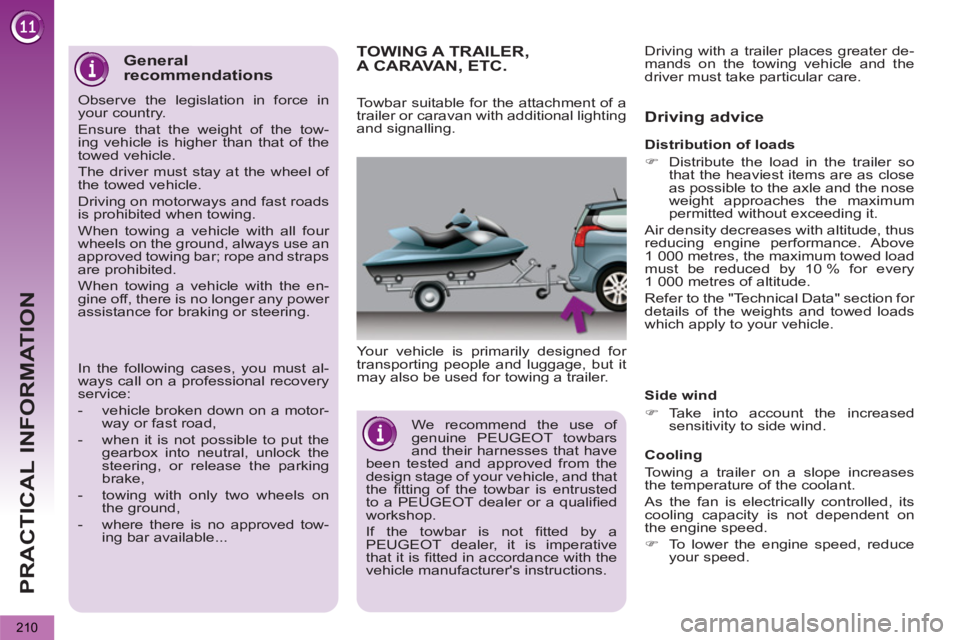
PRACTICAL INFORMATION
210
TOWING A TRAILER, A CARAVAN, ETC.
Your vehicle is primarily designed for
transporting people and luggage, but it
may also be used for towing a trailer.
Driving advice
Side wind
�)
Take into account the increased
sensitivity to side wind.
Cooling
Towing a trailer on a slope increases
the temperature of the coolant.
As the fan is electrically controlled, its
cooling capacity is not dependent on
the engine speed.
�)
To lower the engine speed, reduce
your speed.
Towbar suitable for the attachment of a
trailer or caravan with additional lighting
and signalling.
Distribution of loads
�)
Distribute the load in the trailer so
that the heaviest items are as close
as possible to the axle and the nose
weight approaches the maximum
permitted without exceeding it.
Air density decreases with altitude, thus
reducing engine performance. Above
1 000 metres, the maximum towed load
must be reduced by 10 % for every
1 000 metres of altitude.
Refer to the "Technical Data" section for
details of the weights and towed loads
which apply to your vehicle. Driving with a trailer places greater de-
mands on the towing vehicle and the
driver must take particular care.
We recommend the use of
genuine PEUGEOT towbars
and their harnesses that have
been tested and approved from the
design stage of your vehicle, and that
the fi tting of the towbar is entrusted
to a PEUGEOT dealer or a qualifi ed
workshop.
If the towbar is not fi tted by a
PEUGEOT dealer, it is imperative
that it is fi tted in accordance with the
vehicle manufacturer's instructions.
General
recommendations
Observe the legislation in force in
your country.
Ensure that the weight of the tow-
ing vehicle is higher than that of the
towed vehicle.
The driver must stay at the wheel of
the towed vehicle.
Driving on motorways and fast roads
is prohibited when towing.
When towing a vehicle with all four
wheels on the ground, always use an
approved towing bar; rope and straps
are prohibited.
When towing a vehicle with the en-
gine off, there is no longer any power
assistance for braking or steering.
In the following cases, you must al-
ways call on a professional recovery
service:
- vehicle broken down on a motor-
way or fast road,
- when it is not possible to put the
gearbox into neutral, unlock the
steering, or release the parking
brake,
- towing with only two wheels on
the ground,
- where there is no approved tow-
ing bar available...
Page 213 of 340

PRACTICAL INFORMATION
211
The maximum towed load on a long in-
cline depends on the gradient and the
ambient temperature.
In all cases, keep a check on the cool-
ant temperature.
Braking
Towing a trailer increases the braking
distance.
To avoid overheating of the brakes on a
long mountain type of descent, the use
of engine braking is recommended.
Tyres
�)
Check the tyre pressures of the tow-
ing vehicle and of the trailer, observ-
ing the recommended pressures.
Lighting
�)
Check the electrical lighting and sig-
nalling on the trailer.
The rear parking sensors will
be deactivated automatically if
a genuine PEUGEOT towbar
is used.
�)
If the warning lamp and the
STOP
warning lamp come
on, stop the vehicle and
switch off the engine as
soon as possible.
FITTING ROOF BARS
Maximum authorised weight
on the roof rack, for a loading
height not exceeding 40 cm
(with the exception of bicycle
carriers): 65
kg.
If the height exceeds 40 cm, adapt
the speed of the vehicle to the pro-
fi le of the road to avoid damaging the
roof bars and the fi xings on the roof.
Be sure to refer to national legislation
in order to comply with the regula-
tions for transporting objects that are
longer than the vehicle.
When fi tting transverse roof bars, use
the four quick-fi t fi xings provided for this
purpose:
�)
lift the concealing fl aps,
�)
open the fi xing covers on each bar
using the key,
�)
put each fi xing in place and lock
them on the roof one by one,
�)
ensure that roof bars are correctly
fi tted (by shaking them),
�)
close the fi xing covers on each bar
using the key.
If your vehicle is fi tted with
roof fi nishers, do not use them
for carrying loads.
Page 217 of 340
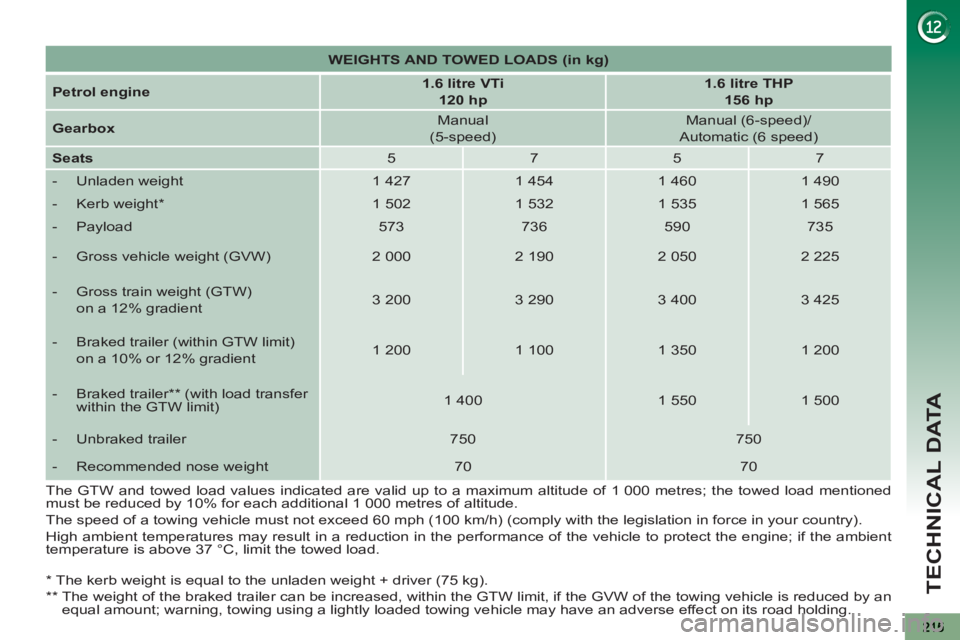
TECHNICAL DATA
*
The kerb weight is equal to the unladen weight + driver (75 kg).
**
The weight of the braked trailer can be increased, within the GTW limit, if the GVW of the towing vehicle is reduced by an
equal amount; warning, towing using a lightly loaded towing vehicle may have an adverse effect on its road holding.
WEIGHTS AND TOWED LOADS (in kg)
Petrol engine
1.6 litre VTi
120 hp
1.6 litre THP
156 hp
Gearbox
Manual
(5-speed)
Manual (6-speed)/
Automatic (6 speed)
Seats
5
7
5
7
- Unladen weight
1 427
1 454
1 460
1 490
- Kerb weight *
1 502
1 532
1 535
1 565
- Payload
573
736
590
735
- Gross vehicle weight (GVW)
2 000
2 190
2 050
2 225
- Gross train weight (GTW)
on a 12% gradient
3 200
3 290
3 400
3 425
- Braked trailer (within GTW limit)
on a 10% or 12% gradient
1 200
1 100
1 350
1 200
- Braked trailer ** (with load transfer
within the GTW limit)
1 400
1 550
1 500
- Unbraked trailer
750
750
- Recommended nose weight
70
70
The GTW and towed load values indicated are valid up to a maximum altitude of 1 000 metres; the towed load mentioned
must be reduced by 10% for each additional 1 000 metres of altitude.
The speed of a towing vehicle must not exceed 60 mph (100 km/h) (comply with the legislation in force in your country).
High ambient temperatures may result in a reduction in the performance of the vehicle to protect the engine; if the ambient
temperature is above 37 °C, limit the towed load.
Page 219 of 340
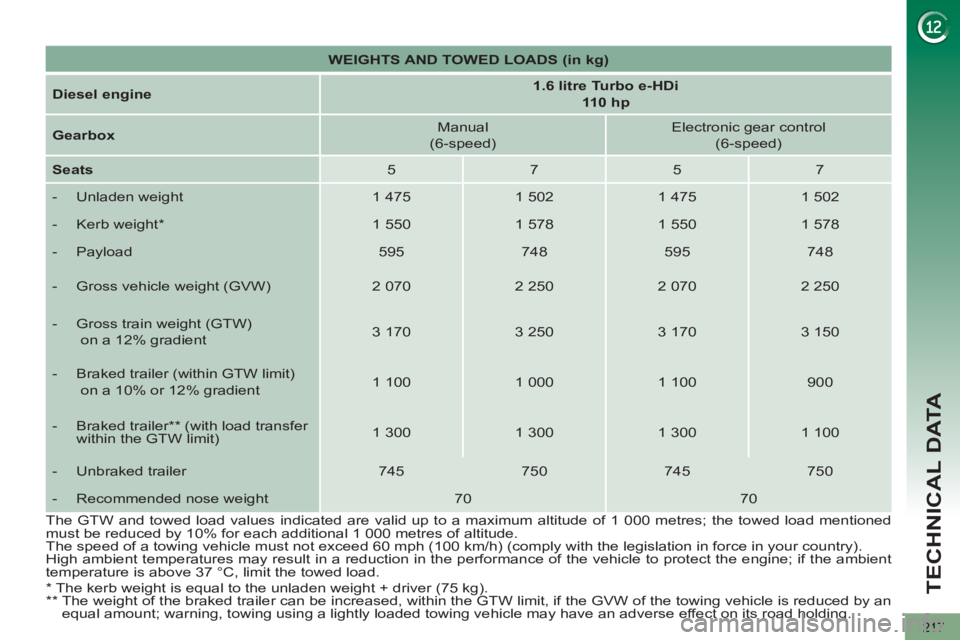
TECHNICAL DATA
217
WEIGHTS AND TOWED LOADS (in kg)
Diesel engine
1.6 litre Turbo e-HDi
110 hp
Gearbox
Manual
(6-speed)
Electronic gear control
(6-speed)
Seats
5
7
5
7
- Unladen weight
1 475
1 502
1 475
1 502
- Kerb weight *
1 550
1 578
1 550
1 578
- Payload
595
748
595
748
- Gross vehicle weight (GVW)
2 070
2 250
2 070
2 250
- Gross train weight (GTW)
on a 12% gradient
3 170
3 250
3 170
3 150
- Braked trailer (within GTW limit)
on a 10% or 12% gradient
1 100
1 000
1 100
900
- Braked trailer ** (with load transfer
within the GTW limit)
1 300
1 300
1 300
1 100
- Unbraked trailer
745
750
745
750
- Recommended nose weight
70
70
*
The kerb weight is equal to the unladen weight + driver (75 kg).
**
The weight of the braked trailer can be increased, within the GTW limit, if the GVW of the towing vehicle is reduced by an
equal amount; warning, towing using a lightly loaded towing vehicle may have an adverse effect on its road holding. The GTW and towed load values indicated are valid up to a maximum altitude of 1 000 metres; the towed load mentioned
must be reduced by 10% for each additional 1 000 metres of altitude.
The speed of a towing vehicle must not exceed 60 mph (100 km/h) (comply with the legislation in force in your country).
High ambient temperatures may result in a reduction in the performance of the vehicle to protect the engine; if the ambient
temperature is above 37 °C, limit the towed load.
Page 220 of 340
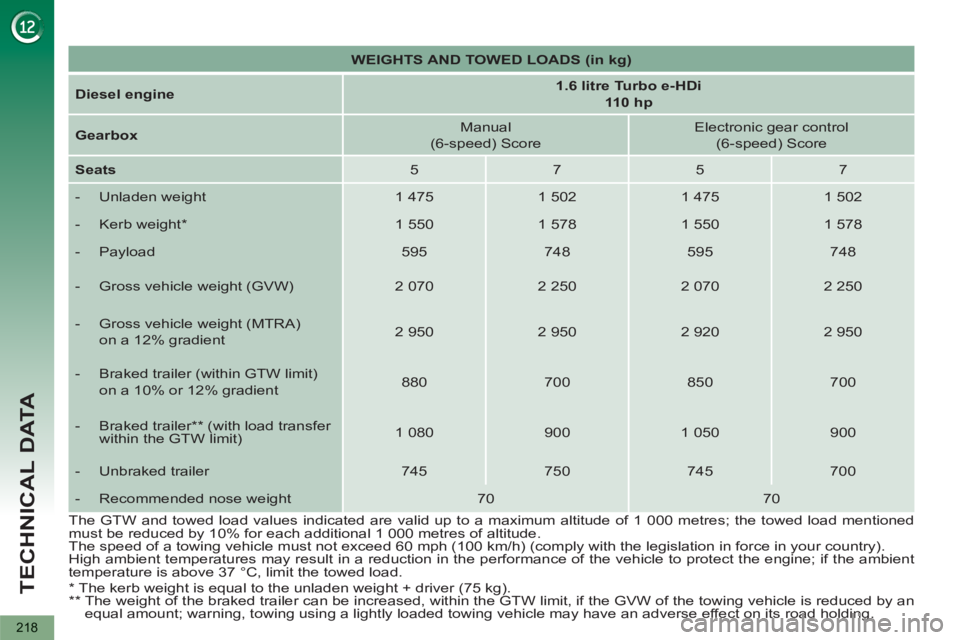
TECHNICAL DATA
218
WEIGHTS AND TOWED LOADS (in kg)
Diesel engine
1.6 litre Turbo e-HDi
110 hp
Gearbox
Manual
(6-speed) Score
Electronic gear control
(6-speed) Score
Seats
5
7
5
7
- Unladen weight
1 475
1 502
1 475
1 502
- Kerb weight *
1 550
1 578
1 550
1 578
- Payload
595
748
595
748
- Gross vehicle weight (GVW)
2 070
2 250
2 070
2 250
- Gross vehicle weight (MTRA)
on a 12% gradient
2 950
2 950
2 920
2 950
- Braked trailer (within GTW limit)
on a 10% or 12% gradient
880
700
850
700
- Braked trailer ** (with load transfer
within the GTW limit)
1 080
900
1 050
900
- Unbraked trailer
745
750
745
700
- Recommended nose weight
70
70
The GTW and towed load values indicated are valid up to a maximum altitude of 1 000 metres; the towed load mentioned
must be reduced by 10% for each additional 1 000 metres of altitude.
The speed of a towing vehicle must not exceed 60 mph (100 km/h) (comply with the legislation in force in your country).
High ambient temperatures may result in a reduction in the performance of the vehicle to protect the engine; if the ambient
temperature is above 37 °C, limit the towed load.
*
The kerb weight is equal to the unladen weight + driver (75 kg).
**
The weight of the braked trailer can be increased, within the GTW limit, if the GVW of the towing vehicle is reduced by an
equal amount; warning, towing using a lightly loaded towing vehicle may have an adverse effect on its road holding.
Page 221 of 340
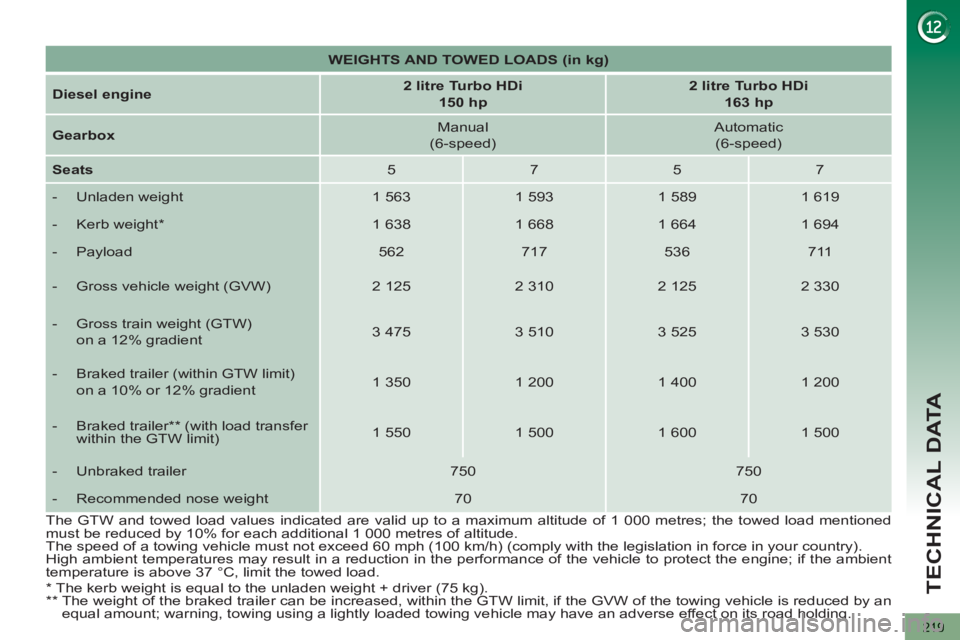
TECHNICAL DATA
219
WEIGHTS AND TOWED LOADS (in kg)
Diesel engine
2 litre Turbo HDi
150 hp
2 litre Turbo HDi
163 hp
Gearbox
Manual
(6-speed)
Automatic
(6-speed)
Seats
5
7
5
7
- Unladen weight
1 563
1 593
1 589
1 619
- Kerb weight *
1 638
1 668
1 664
1 694
- Payload
562
717
536
711
- Gross vehicle weight (GVW)
2 125
2 310
2 125
2 330
- Gross train weight (GTW)
on a 12% gradient
3 475
3 510
3 525
3 530
- Braked trailer (within GTW limit)
on a 10% or 12% gradient
1 350
1 200
1 400
1 200
- Braked trailer ** (with load transfer
within the GTW limit)
1 550
1 500
1 600
1 500
- Unbraked trailer
750
750
- Recommended nose weight
70
70
The GTW and towed load values indicated are valid up to a maximum altitude of 1 000 metres; the towed load mentioned
must be reduced by 10% for each additional 1 000 metres of altitude.
The speed of a towing vehicle must not exceed 60 mph (100 km/h) (comply with the legislation in force in your country).
High ambient temperatures may result in a reduction in the performance of the vehicle to protect the engine; if the ambient
temperature is above 37 °C, limit the towed load.
*
The kerb weight is equal to the unladen weight + driver (75 kg).
**
The weight of the braked trailer can be increased, within the GTW limit, if the GVW of the towing vehicle is reduced by an
equal amount; warning, towing using a lightly loaded towing vehicle may have an adverse effect on its road holding.
Page 222 of 340
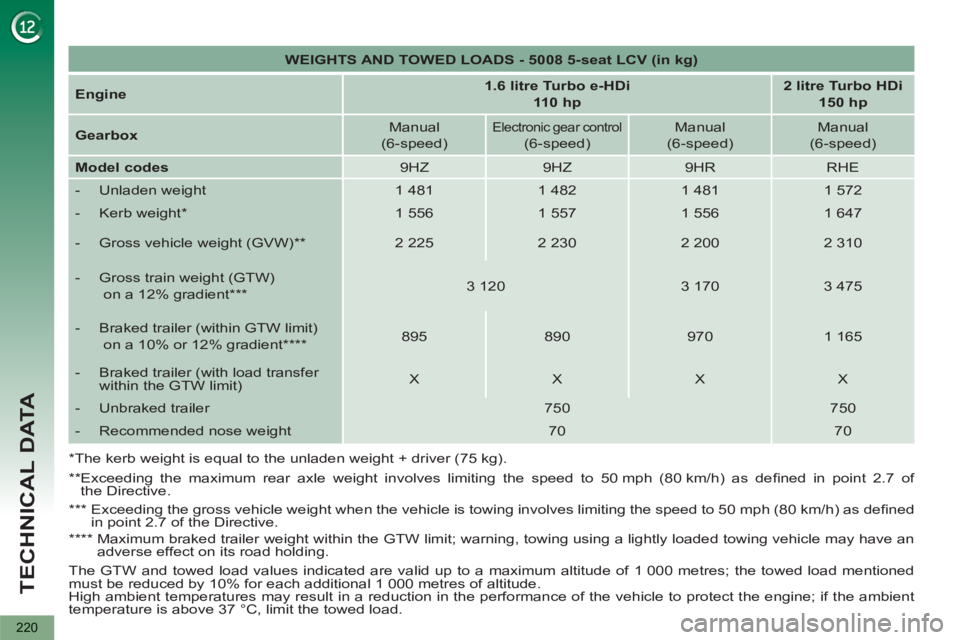
TECHNICAL DATA
220
WEIGHTS AND TOWED LOADS - 5008 5-seat LCV (in kg)
Engine
1.6 litre Turbo e-HDi
110 hp
2 litre Turbo HDi
150 hp
Gearbox
Manual
(6-speed)
Electronic gear control
(6-speed)
Manual
(6-speed)
Manual
(6-speed)
Model codes
9HZ
9HZ
9HR
RHE
- Unladen weight
1 481
1 482
1 481
1 572
- Kerb weight *
1 556
1 557
1 556
1 647
- Gross vehicle weight (GVW) **
2 225
2 230
2 200
2 310
- Gross train weight (GTW)
on a 12% gradient ***
3 120
3 170
3 475
- Braked trailer (within GTW limit)
on a 10% or 12% gradient ****
895
890
970
1 165
- Braked trailer (with load transfer
within the GTW limit)
X
X
X
X
- Unbraked trailer
750
750
- Recommended nose weight
70
70
*
The kerb weight is equal to the unladen weight + driver (75 kg).
**
Exceeding the maximum rear axle weight involves limiting the speed to 50 mph (80 km/h) as defi ned in point 2.7 of
the Directive.
***
Exceeding the gross vehicle weight when the vehicle is towing involves limiting the speed to 50 mph (80 km/h) as defi ned
in point 2.7 of the Directive.
****
Maximum braked trailer weight within the GTW limit; warning, towing using a lightly loaded towing vehicle may have an
adverse effect on its road holding.
The GTW and towed load values indicated are valid up to a maximum altitude of 1 000 metres; the towed load mentioned
must be reduced by 10% for each additional 1 000 metres of altitude.
High ambient temperatures may result in a reduction in the performance of the vehicle to protect the engine; if the ambient
temperature is above 37 °C, limit the towed load.
Page 330 of 340
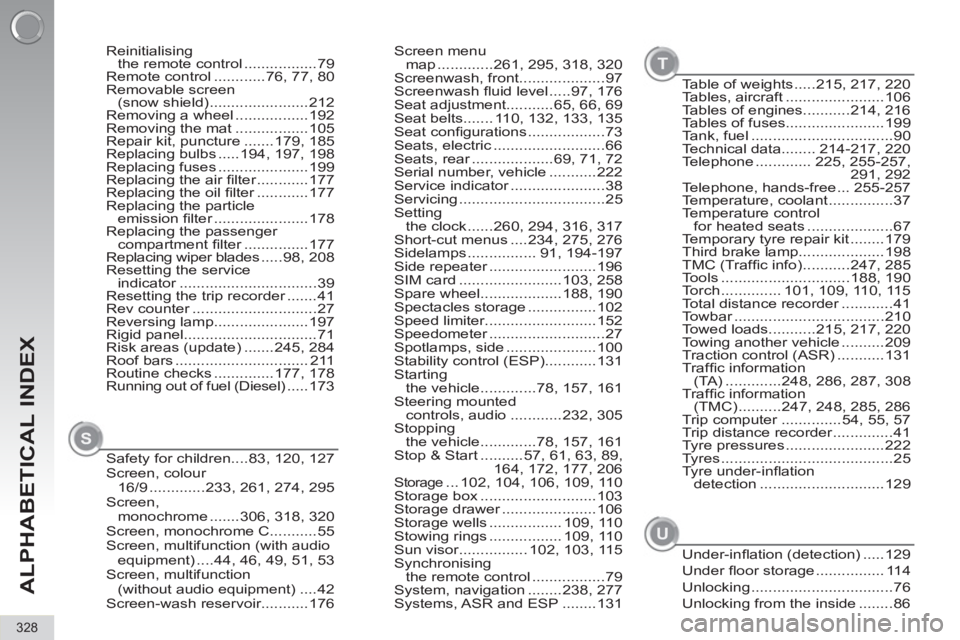
ALPHABETICAL INDEX
328
Screen menu
map .............261, 295, 318, 320
Screenwash, front....................97
Screenwash fl uid level .....97, 176
Seat adjustment...........65, 66, 69
Seat belts....... 110, 132, 133, 135
Seat confi gurations ..................73
Seats, electric ..........................66
Seats, rear ...................69, 71, 72
Serial number, vehicle ...........222
Service indicator ......................38
Servicing ..................................25
Setting
the clock ......260, 294, 316, 317
Short-cut menus ....234, 275, 276
Sidelamps ................ 91, 194-197
Side repeater .........................196
SIM card ........................103, 258
Spare wheel...................188, 190
Spectacles storage ................102
Speed limiter..........................152
Speedometer ...........................27
Spotlamps, side .....................100
Stability control (ESP)............131
Starting
the vehicle .............78, 157, 161
Steering mounted
controls, audio ............232, 305
Stopping
the vehicle .............78, 157, 161
Stop & Start ..........57, 61, 63, 89,
164, 172, 177, 206
Storage ... 102, 104, 106, 109, 110
Storage box ...........................103
Storage drawer ......................106
Storage wells ................. 109, 110
Stowing rings ................. 109, 110
Sun visor................ 102, 103, 115
Synchronising
the remote control .................79
System, navigation ........238, 277
Systems, ASR and ESP ........131 Reinitialising
the remote control .................79
Remote control ............76, 77, 80
Removable screen
(snow shield) .......................212
Removing a wheel .................192
Removing the mat .................105
Repair kit, puncture .......179, 185
Replacing bulbs .....194, 197, 198
Replacing fuses .....................199
Replacing the air fi lter ............177
Replacing the oil fi lter ............177
Replacing the particle
emission fi lter ......................178
Replacing the passenger
compartment fi lter ...............177
Replacing wiper blades .....98, 208
Resetting the service
indicator ................................39
Resetting the trip recorder .......41
Rev counter .............................27
Reversing lamp......................197
Rigid panel...............................71
Risk areas (update) .......245, 284
Roof bars ............................... 211
Routine checks ..............177, 178
Running out of fuel (Diesel) .....173
Safety for children....83, 120, 127
Screen, colour
16/9 .............233, 261, 274, 295
Screen,
monochrome .......306, 318, 320
Screen, monochrome C...........55
Screen, multifunction (with audio
equipment) ....44, 46, 49, 51, 53
Screen, multifunction
(without audio equipment) ....42
Screen-wash reservoir...........176
S
Table of weights .....215, 217, 220
Tables, aircraft .......................106
Tables of engines...........214, 216
Tables of fuses.......................199
Tank, fuel .................................90
Technical data........ 214-217, 220
Telephone ............. 225, 255-257,
291, 292
Telephone, hands-free ... 255-257
Temperature, coolant ...............37
Temperature control
for heated seats ....................67
Temporary tyre repair kit ........179
Third brake lamp....................198
TMC (Traffi c info) ...........247, 285
Tools ..............................188, 190
Torch .............. 101, 109, 110, 115
Total distance recorder ............41
Towbar ...................................210
Towed loads...........215, 217, 220
Towing another vehicle ..........209
Traction control (ASR) ...........131
Traffi c information
(TA) .............248, 286, 287, 308
Traffi c information
(TMC) ..........247, 248, 285, 286
Trip computer ..............54, 55, 57
Trip distance recorder ..............41
Tyre pressures .......................222
Tyres ........................................25
Tyre under-infl ation
detection .............................129
T
Under-infl ation (detection) .....129
Under fl oor storage ................ 114
Unlocking .................................76
Unlocking from the inside ........86
U